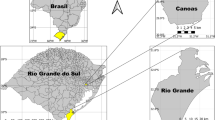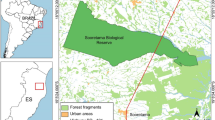Abstract
Studying the occurrence of Leishmania in bats would help toward clarifying the role of these animals in epidemiological cycles. Therefore, the objective of this study was to detect Leishmania spp. in bats from the Brazilian State of Espírito Santo. In total, 105 bats from 11 species which had been collected from 17 municipalities of Espírito Santo were obtained from the IDAF Rabies Diagnostic Laboratory between December 2018 and June 2019. DNA was extracted from the bone marrow, skin, and spleen samples and analysed using conventional PCR, with primers specific for the kinetoplastic DNA minicircle of the parasitic species Leishmania (Viannnia) braziliensis, Leishmania (Leishmania) infantum, and Leishmania (Leishmania) amazonensis. To identify the Leishmania species, the positive PCR products were analysed using PCR-RFLP with the HaeIII enzyme and 8% polyacrylamide gel electrophoresis. Positivity for L. (V.) braziliensis was observed in five (4.76%) bats: namely, one male Eumops glaucinus from Vitória (in a skin sample), one male Artibeus lituratus from Vila Velha and one female Eumops glaucinus from Vitória (both in bone marrow samples), and one male A. lituratus from Vitória and one male Molossus rufus from Guarapari (both in the spleen samples). To our best knowledge, this is the first report of the detection of Leishmania in bats from Espírito Santo as well as of Leishmania DNA in the bone marrow of bats.



Similar content being viewed by others
Data availability
All data generated or analysed during this study are included in this published article.
References
Akhoundi M, Kuhls K, Cannet A, Votýpka J, Marty P, Delaunay P, Sereno D (2016) A Historical overview of the classification, evolution, and dispersion of Leishmania parasites and sandflies. PLoS Negl Trop Dis 10(3):e0004349. https://doi.org/10.1371/journal.pntd.0004349
Berzunza-Cruz M, Rodriguez-Moreno A, Gutiérrez-Granados G, González-Salazar C, Stephes CR, Hidalgo-Mihart M, Marina CF, Rebollar-Téllez EA, Bailón-Martinez D, Balcells CD, Ibarra-Cerdeña CN, Sánchez-Cordero V, Becker I (2015) Leishmania (L.) Mexicana infected bats in Mexico: novel potential reservoirs. PLOS Negl Trop Dis 9(1):1–15. https://doi.org/10.1371/journal.pntd.0003438
Conter CC, Lonardoni MVC, Aristides SMA, Cardoso RF, Silveira TGV (2018) New primers for the detection Leishmania species by multiplex polymerase chain reaction. Parasitol Res 117:501–511. https://doi.org/10.1007/s00436-017-5726-1
Falqueto A, Sessa PA, Ferreira AL, Vieira VP, Santos CB, Varejão JBM, Cupolillo E, Porrozzi R, Carvalho-Paes LE, Grimaldi Jr G (2003) Epidemiological and clinical features of Leishmania (Viannia) braziliensis american cutaneous and mucocutaneous leishmaniasis in the State of Espírito Santo, Brazil. Mem Inst Oswaldo Cruz 98(8):1003–1010. https://doi.org/10.1590/S0074-02762003000800004
Ferreira EC, Pereira AAS, Silveira M, Margonari C, Marcon GEB, França AO, Castro LS, Bordignon MO, Fischer E, Tomas WM, Dorval MEC, Gontijo CMF (2017) Leishmania (V.) braziliensis infecting bats from Pantanal wetland, Brazil: first records for Platyrrhinus lineatus and Artibeus planirostris. Acta Trop 172:217–222. https://doi.org/10.1016/j.actatropica.2017.05.012
Fraenkel S, Salvioni OD, Arias AR, Arze VP, Rolón M, Ramirez N, Gómez CV (2020) Identification of bloodmeal sources of triatomines captured in the Paraguayan Chaco region of South America by means of molecular biology analysis. Pathogens and Global Health. https://doi.org/10.1080/20477724.2020.1716558
Gómez-Hernández C, Bento EC, Oliveira KR, Nascentes GAN, Barbosa CG, Batista LR, Tiburcio MGS, Pedrosa AL, Silva EL, Ramirez JD, Ramirez LE (2017) Leishmania infection in bats from a non-endemic region of leishmaniasis in Brazil. Parasitol 144:1980–1986. https://doi.org/10.1017/S0031182017001500
Green MR, Sambrook J (2012) Molecular cloning: a laboratory manual. Cold Spring Harbor, New York, 1890p
Kassahun A, Sadlova J, Benda P, Kostalova T, Warburg A, Hailu A, Baneth G, Volf P, Votypka J (2015) Natural infection of bats with Leishmania in Ethiopia. Acta Trop 150:166–170. https://doi.org/10.1016/j.actatropica.2015.07.024
Lampo M, Feliciangeli MD, Marquez LM, Bastidas C, Lau P (2000) A possible role of bats as a blood source for the Leishmania vector Lutzomyia longipalpis (Diptera: Psychodidae). Am J Trop Med Hyg 62(6):718–719. https://doi.org/10.4269/ajtmh.2000.62.718
Lima H, Rodriguez N, Barrios MA, Avila A, Canizales I, Gutierrez S (2008) Isolation and molecular identification of Leishmania chagasi from a bat (Carollia perspicillata) in northeastern Venezuela. Mem Inst Oswaldo Cruz 103(4):412–414. https://doi.org/10.1590/S0074-02762008000400018
Montalvo AM, Fraga J, Romero JA, Monzote L, Montano I, Dujardin JC (2006) PCR-RFLP/Hsp70 para identificar y tipificar Leishmania de la región neotropical. Ver Cubana Med Trop 58(3):226–234
Oliveira FM, Costa LHC, Barros TL, Ito PKRK, Colombo FA, Carvalho C, Pedro WA, Queiroz LH, Nunes CM (2015) First detection of Leishmania spp. DNA in Brazilian bats captured strictly in urban areas. Acta Trop 150:176–181. https://doi.org/10.1016/j.actatropica.2015.07.010
Paula MBC, Souza AA, Reis AA, Limongi JE, Pajuaba Neto AA, Rodrigues EAS (2013) Survey of sandfly fauna (Diptera: Psychodidae) in Uberlândia, Minas Gerais State, Brazil, 2003–2004. Ver Inst Med Trop São Paulo 55 (2):85–89. https://doi.org/10.1590/S0036-46652013000200004
Pinto IS, Loss ACC, Falqueto A, Leite YLR (2009) Pequenos mamíferos não voadores em fragmentos de mata atlântica e áreas agrícolas em Viana, Espírito Santo, Brasil. Biota Neotrop 9(3):355–360. https://doi.org/10.1590/S1676-06032009000300030
Quaresma PF, Murta SMF, Ferreira EC, Rocha-Lima ACVM, Xavier AAP, Gontijo CMF (2009) Molecular diagnosis of canine visceral leishmaniasis: Identification of Leishmania species by PCR-RFLP and quantification of parasite DNA by real-time PCR. Acta Trop 111:289–294. https://doi.org/10.1016/j.actatropica.2009.05.008
Rezende MB, Herrera HM, Carvalho CME, Anjos EAC, Ramos CAN, Araújo FR, Torres JM, Oliveira CE (2017) Detection of Leishmania spp. in bats from an area of Brazil endemic for visceral Leishmaniasis. Trans Emerg Dis 64:36–42. https://doi.org/10.1111/tbed.12597
Rocha MN, Margonari C, Presot IM, Soares RP (2010) Evaluation of 4 polymerase chain reaction protocols for cultured Leishmania spp. typing. Diagn Microbiol Infect Dis 68:401–409. https://doi.org/10.1016/j.diagmicrobio.2010.08.007
Savani ESMM, Almeida MF, Camargo MCGO, D’Auria SRN, Silva MMS, Oliveira ML, Sacramento D (2010) Detection of Leishmania (Leishmania) amazonensis and Leishmania (Leishmania) infantum chagasi in Brazilian bats. Vet Parasitol 168:5–10. https://doi.org/10.1016/j.vetpar.2009.10.019
Shapiro JP, Lima MSC Jr, Dorval MEC, França AO, Matos MFC, Bordignon MO (2013) First record of Leishmania braziliensis presence detected in bats, Mato Grosso do Sul, southwest Brazil. Acta Trop 128(1):171–174. https://doi.org/10.1016/j.actatropica.2013.07.004
Taylor LH, Latham SM, Wollhouse MEJ (2001) Risk factors for human disease emergence. Philosop Trans Royal Society London B 356:983–989. https://doi.org/10.1098/rstb.2001.0888
Tonini MAL, Lemos EM, Reis AB, Vital WC, Dias ES, Dietze R (2012) First description of autochthonous canine visceral leishmaniasis in the metropolitan region of Vitória, State of Espírito Santo, Brazil. Rev Soc Bras Med Trop 45(6):754–756. https://doi.org/10.1590/S0037-86822012000600019
Vieira TM, Araújo WS, Pereira AAS, Desiderio EO, Santos BO, Vieira MVL, Gontijo CMF, Melo MN (2018) Redes de interação entre morcegos e Leishmania em ambiente silvestre e urbano do município de Montes Claros, MG, Brasil. MEDTROP. 54 Congresso Da Sociedade Brasileira De Medicina Tropical. Pernambuco
Vizotto LD, Taddei VA (1973) Chave para determinação de quirópteros brasileiros. Revista da Faculdade de Filosofia, Ciências e Letras de São José do Rio Preto – São José do Rio Preto, Boletim de Ciências, pp. 1–72
WHO - World Health Organization. Neglected infectious diseases: Leishmaniasis – Key data. 2017. Disponível em: <https://www.paho.org/hq/dmdocuments/2017/2017-cha-leishmaniasis-factsheet-work.pdf>. Acesso em 20 de junho de 2020
Funding
This study was financed in part by the Fundação de Amparo à Pesquisa e Inovação do Estado do Espírito Santo (FAPES) and the Coordenação de Aperfeiçoamento de Pessoal de Nível Superior - Brasil (CAPES) - Finance Code 001.
Author information
Authors and Affiliations
Contributions
All authors contributed to the study conception and design. Material preparation, data collection and analysis were performed by Mayara Mezabarba Riva, Felipe Martins Pastor, Yuri Vieira Almeida, Lívia Martino Duarte, Lígia Isabelle Silva Souza, Marcos Santos Zanini, Maria Aparecida da Silva. The first draft of the manuscript was written by Mayara Mezabarba Riva and all authors commented on previous versions of the manuscript. All authors read and approved the final manuscript.
Corresponding author
Ethics declarations
Conflict of interest
The authors declare that they have no conflict of interest.
Consent to participate
Not applicable.
Consent for publication
Not applicable.
Code availability
Not applicable.
Additional information
Section Editor: Sarah Hendrickx
Publisher’s note
Springer Nature remains neutral with regard to jurisdictional claims in published maps and institutional affiliations.
Rights and permissions
About this article
Cite this article
Riva, M.M., Pastor, F.M., Almeida, Y.V. et al. Detection of Leishmania (Viannia) braziliensis in bats from Espírito Santo, Brazil (2018–2019). Parasitol Res 120, 3857–3863 (2021). https://doi.org/10.1007/s00436-020-07042-2
Received:
Accepted:
Published:
Issue Date:
DOI: https://doi.org/10.1007/s00436-020-07042-2




